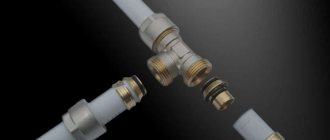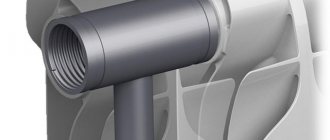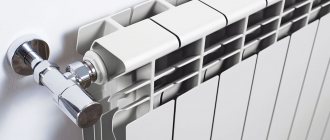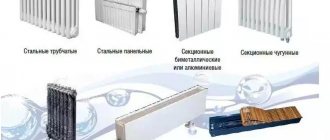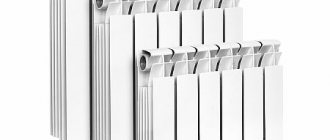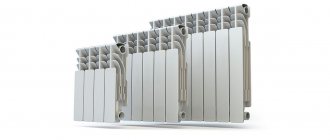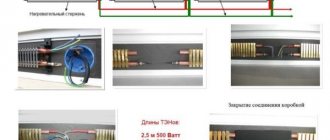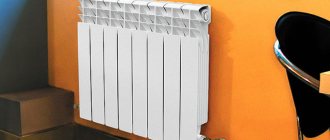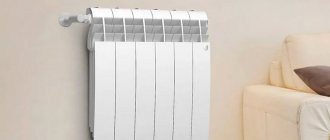After the heating season ends, many begin to think about replacing old radiators. A significant percentage of housing in Russia is represented by panel buildings from Soviet times.
Aluminum radiator - appearance
The cast iron batteries installed inside them, although they can last for decades, sooner or later become unusable. They develop microcracks, rust and become unsafe. As soon as you discover the first holes, rest assured that it’s time to send the cast-iron monsters to a well-deserved rest. To replace them, the market offers two main types of batteries. In order not to get lost in the choice, it is important to understand what is the main difference between aluminum heating radiators and bimetallic ones.
To choose the right radiator model, it is best to contact professional repairmen. However, if this is not possible, you will have to figure it out yourself and consult with sellers in specialized stores.
Some sellers will try to confuse you, because their goal is to sell the product at a higher price. In addition, other careless sellers may try to sell you aluminum radiators under the guise of bimetallic ones, and you should know how to distinguish them so as not to overpay for non-existent additional functions! To avoid falling for their tricks, read this article carefully.
What is an aluminum radiator
Aluminum for batteries is not the same metal from which buckets and pans are made. Special components are added to the alloy to increase heat transfer and improve corrosion resistance.
Batteries made of this metal look “complex” - they are made of a large number of thin elements. This petal design increases heat transfer: the device works both as a sectional radiator and as a convector.
The best radiators are made from aluminum alloy - silumin. It contains about 12% silicon - this provides products with high strength.
Each section of such radiators is cast under pressure and then welded in an inert gas environment.
A simpler and cheaper option is extrusion models. Such products are not cast; they are extruded through an extruder under high pressure. The parts are then press fit with the upper and lower manifolds cast. This method of connecting parts is unreliable. If pressure builds up in the system, the extrusion cooler may burst.
If you are unlucky with the manufacturer, the seams will come apart even with careless installation.
Cheap Chinese models are even worse. The battery parts are not pressed into them, but are attached to composite glue.
Advice. Pay attention to the manufacturer's reputation. Don't save money, choose proven brands with good reviews.
What is a bimetallic radiator
The bimetallic structure consists of two parts:
- a steel pipe frame through which the coolant flows.
- The aluminum body is the one that, when warmed up, releases heat into the surrounding space.
This design combines strength and high thermal conductivity.
The principle of operation is simple: the coolant moves along the steel core and warms it. Heat from the steel is transferred to the external ribbed structure, and then to the environment.
Some radiators have internal cores made of copper. This is the most reliable and most practical option. Such batteries will even withstand antifreeze in the coolant. But on the Russian market, radiators with a copper core are rare.
There is also a compromise option - semi-bimetallic models. Their core is made of two metals:
- vertical channels are made of steel.
- horizontal – aluminum.
This design has higher heat transfer than classic bimetallic options. But there are two problems:
- alkaline or too acidic water will cause corrosion in aluminum tubes;
- aluminum and steel have different thermal expansion - which means the cores can move, and this will affect the operation of the system.
Therefore, semi-bimetallic models are rarely installed. They are more expensive than aluminum and retain all of its key disadvantages.
What is the difference?
Visually, aluminum and bimetallic structures are very similar. They can only be distinguished by weight - metal is heavier.
But there are also design differences.
- Manufacturing technique. Aluminum radiators are cast as a single product, which means they are solid. A bimetal is a structure connected from two different elements.
- Contact with coolant. In aluminum batteries, the filler flows through channels made of aluminum alloy. In bimetallic, the coolant moves through steel tubes that are filled with aluminum alloy. There is no direct contact with the outer surface.
- Internal section. Two-component batteries have a smaller core diameter.
The pros and cons of radiators depend on differences in design.
comparison table
Let's collect all the features of radiators in one table.
| Characteristic | Aluminum batteries | Bimetallic batteries |
| Thermal conductivity | + | — |
| Low inertia | + | — |
| Response to thermostat commands | — | + |
| High pressure resistance | — | + |
| Corrosion resistance | — | + |
| Weight | + | — |
| Internal cross-sectional area | + | — |
| Easy to install | — | + |
| Life time | — | + |
| Price for 1 section. Economy option. | 300 rub. | 400 rub. |
We recommend: Which pedicure is better - hardware or edged: expert advice on choosing a procedure
The price difference is small, but the table shows the cost of only one section. Let's assume that there are 10 such sections in one battery. Then the difference in price will be 1000 rubles. For three rooms this is already 3000 rubles.
Please note: we indicated the price of radiators “net” - only for the device. Some manufacturers include insurance in the price, others - a warranty. There are companies that do both – in this case the price increases. The installation company can add its own markup, which will further increase the cost.
Comparison using two models as an example
Let's compare in detail two models with similar characteristics and parameters, for example, the same Rifar Alum 500 12 sections (width 960 mm, height 565 mm) and Rifar Base 500 12 sections (width 948 mm, height 570 mm)..
| Radiator type | Aluminum | Bimetallic |
| Maximum coolant temperature, °C | 135 | 135 |
| Working pressure, bar | 20 | 20 |
| Crimping pressure, bar | 30 | 30 |
| Coolant volume, l | 3,24 | 2,4 |
| Corrosion resistance | average - | average + |
| Heated area, m2 | 24 | 24 |
| Heat dissipation, W | 2 196 | 2 448 |
| Warranty, years | 10 | 10 |
| Service life, years | 25 | 25 |
| price, rub. | 9 030 | 10 640 |
| Cost per 1 kW, rub. | 4 112 | 4 346 |
| Heat transfer per 1 liter of coolant, W | 678 | 1 020 |
The table clearly shows that, other things being equal, bimetallic radiators require less coolant. The difference in cost of the selected models is only 10%, approximately the same as the difference in heat transfer, but the difference in cost per 1 kW is only 5%.
Pros and cons of aluminum radiators
These devices are universal: convenient, economical, effective. But they also have disadvantages.
Advantages
Let's analyze the advantages of aluminum.
- High thermal conductivity.
For aluminum, this figure is 2-4 times higher than for bimetallic devices, steel or cast iron.
- Compact sizes.
Since aluminum has high heat transfer, the size of radiators can be reduced by 2-3 times. And this will not affect the temperature in the room at all.
- Aluminum has low inertia - batteries heat up easily and cool down easily.
This is convenient when you want to quickly change the temperature in the room. To control the heating level of the batteries, install thermostats on them. This way you will not depend on the temperature of the coolant in the system.
- Radiators have a wide range of operating and pressure testing.
Such devices are universal - they are installed in both open and closed systems.
- Low weight.
Radiators are easy to carry and install.
- A large number of design solutions.
There are a lot of models on the market, and if you wish, you can order radiators according to your own sketch.
Flaws
Aluminum also has disadvantages.
- Sensitivity to the pH level of the coolant.
If your house has too acidic water flowing through the pipes, the batteries will begin to rust. Hence the problems with European radiators. Many Russians complain that appliances that were supposed to last 20-30 years began to rust after 5 years of use.
- Fragility.
The best manufacturers provide a 15-year warranty on radiators. This is less than competitors.
- There may be problems with installation.
Aluminum is a soft metal. During installation, an inexperienced technician may damage the structure.
- Hydrogen may be generated upon contact with coolant.
Install automatic air vents on all batteries and the problem is solved.
Hydrogen is non-toxic and is part of the air we breathe. But upon contact with fire, pure hydrogen explodes. Therefore, under no circumstances check the presence of hydrogen in the system with a match.
Strapping methods (connection methods)
First, let's look at the types of heating systems:
1. Single-pipe system. With this scheme, a pipe with hot coolant passes sequentially through all radiators, and returns from the last one in the chain with already cooled coolant. Advantages: — Less material (pipes) is consumed. — Less labor-intensive (less floors or walls are broken through during installation). Disadvantages: - Uneven heating of batteries. — More intensive operation of the heating boiler (the coolant returns at a low temperature).
2. Two-pipe system. In turn, they distinguish: vertical - from the riser with coolant, pipes go to each battery separately, and from it they return to another riser with cooled coolant; horizontally radial - pipes to each battery are supplied through a “comb” device, which is connected to a hot pipe.
In each of these types, it is possible to combine different radiator connection schemes:
1. Side diagram. The inlet and outlet pipes are mounted on one side of the battery. The hot coolant enters the upper pipe and cools out of the lower one. (the most common scheme). With such a scheme, it is necessary to have a Mayevsky valve on the “blind” side of the battery to bleed air.
2. Diagonal pattern. The inlet pipe is located at the top on one side, and the outlet at the bottom on the other. This circuit is more optimal from the point of view of heat transfer and is used to connect extended, multi-section batteries.
3. Bottom connection. The inlet and outlet pipes are located at the bottom on different sides of the radiator. This scheme is the least effective, but is very popular when you need to hide the supply and discharge pipes under the floor or behind a decorative baseboard.
When connecting radiators to a single-pipe circuit, a mandatory technical condition is the use of a “bypass”. This is a vertical pipe connecting the inlet and outlet pipes to the battery. Designed to regulate the heat supply to the room, but not to disconnect all radiators that come after the current one from heating. The bypass is made of a smaller diameter to ensure the correct direction of coolant flow. Two ball valves are installed between the bypass and the heating radiator, at the inlet and outlet of the coolant. When they are closed, water will continue to circulate in the system. Less commonly used is a scheme with one three-way valve installed on the hot water pipe, with a bypass connected to it on the third turn.
Pros and cons of bimetallic radiators
These radiators are more expensive - and the high price is justified. Two-component batteries have many advantages, but few disadvantages.
Advantages
The basis of bimetallic structures is steel pipes. Hence the main advantages of these radiators.
- High anti-corrosion resistance.
Bimetallic structures will withstand both the high pH of the coolant and the presence of oxygen in the system.
- High strength.
The metal will withstand both high pressure in the system and water hammer - this is the name for sudden surges in pressure. They occur when pumps are stopped or started. High-quality batteries have a maximum strength level of up to 50 atm, and the most severe water hammer in the system does not exceed 25 atm.
- High inertness compared to aluminum.
Bimetallic pipes cool slowly - in some cases this is a plus.
- Quickly respond to thermostat commands.
Since the internal diameter of the bimetallic structure is lower, less coolant fits into it. The smaller the volume of liquid, the faster it will heat up or cool down.
- Durability.
High-quality products will last you 20-30 years.
Flaws
There are only two disadvantages to two-piece radiators.
- Low cross-sectional area.
Metal pipes are narrower, which means they are more easily clogged with rust and calcium deposits.
- The prefabricated structure is less reliable.
This radiator consists of two structural elements: steel pipes inside, and an aluminum “jacket” outside. This means that connections may become disconnected. This happens rarely and only with low-quality batteries, but still keep this point in mind.
We recommend: To be better than a real one, how to choose an artificial Christmas tree?
How to distinguish
Externally, both types of batteries are very similar, so problems arise when choosing. Knowing how to visually distinguish an aluminum radiator from a bimetallic one, you can independently choose the appropriate model for your home or apartment. There are signs that allow you to quickly determine the type of equipment you need.
Section options Source otoplenie-expert.com
Pure aluminum batteries are lighter in weight than bimetal structures. Sections of the same size and shape will vary in weight. The steel core is 0.5 kg heavier than one-piece models.
How to choose a design Source yandex.ua
In order not to confuse structures made of different materials, professionals recommend inspecting the threads. In a bimetallic radiator, in areas where water passes through, the integrity of the structure is noticeable. A silvery layer of aluminum is visible on the gray surface of the steel pipe. There is a color transition between the two metals.
Understanding how to distinguish an aluminum radiator from a bimetallic one visually, you can determine the desired model by ear. If you knock on steel, the sound will be loud. The one-piece design produces a dull tone. The check is carried out with a wooden pencil, nail or plastic pen.
How not to make a mistake with the view Source pirco.ru
A magnet will help you find out the type of material. The internal steel filling attracts the device, but aluminum has no attraction. The device is brought closer to the center of the structure, where the metal pipe is located.
What is better to choose
The difference between bimetallic and aluminum radiators is not that big. To make the right choice, answer a few questions.
- Is the system filled with high-quality coolant?
If the pH is normal and there is no oxygen in the liquid, install any radiators. But if the coolant is chemically aggressive, only a bimetallic structure will withstand contact with it.
- Do you have spacious rooms?
If yes, you can choose any option. No? Then install aluminum. Radiators made of this metal provide excellent heating, but are 2 times smaller in size than their analogues.
- Does your heating often turn off in winter?
If this happens, choose bimetallic batteries. They retain heat well, which means the room will remain warm for a long time. Aluminum will cool down in 20-30 minutes.
- Is the pressure in the system stable, or does water hammer occur?
If there are sudden pressure surges, choose a design with steel elements - it is stronger.
For a private home, this problem is not relevant - the pumps in the system are too weak, the operating pressure rarely exceeds 3 bar. Any radiator can withstand such a load.
- Is the coolant clean?
In some cities, rusty, highly mineralized water is pumped into the system. Such liquid will quickly clog narrow pipes, which means that two-component batteries are not suitable. Choose aluminum ones - they have a wider internal cross-section.
Ability to hold pressure
In a traditional central heating system, typical of multi-storey buildings, the pressure is by no means stable. Sometimes even water hammer occurs. After all, according to the rules, the taps of circulation pumps should turn on smoothly, but often workers do not follow these rules. And when the hot water is suddenly turned off, its pressure in the entire system jumps so much that many batteries burst. Therefore, apartment residents should definitely choose radiators with a good pressure reserve.
Cast iron radiators can withstand 9-12 atmospheres of pressure. This may be sufficient until a strong water hammer occurs. If it does happen, then the brittle cast iron, unfortunately, may burst. Therefore, if you look from this point of view, whether cast iron or bimetallic radiators are better, then it is better, of course, to play it safe and take a bimetallic one.
Why experts do not advise clients to use cast iron batteries
Cast iron radiators used to be everywhere, but now they are rare. There are many reasons:
- High inertia.
Cast iron heats up slowly and cools just as slowly. This is good if the heating in the house is often turned off. But if not, you will not be able to regulate the temperature in the room. It will take more than an hour for the thermostat to respond to commands.
- Heat transfer from cast iron is lower.
To ensure a comfortable temperature, more cast iron sections will have to be installed.
- These radiators are very heavy.
And the problem is not transportation. Not every wall will support the weight of a cast iron battery of 10-12 sections. Such radiators can destroy even a bulk wall, let alone drywall.
- Few design solutions.
Many cast iron batteries look like “relics”. It is good if the interior of the room is made in a retro style. But if you prefer more modern design options, cast iron will not fit into them.
What's wrong with steel radiators
Another option that is on the market, but is not popular. Steel batteries:
- They rust easily.
An acidic or alkaline environment will kill such batteries. You can’t even drain water from them - air will fill the voids, and the walls of the radiators will begin to rust from the inside.
Narrow passage area.
Contaminated rusty coolant will quickly clog the internal cores.
- Unresistant to hydraulic shocks.
Steel batteries cannot be installed in buildings with 9 floors or higher. If the system malfunctions, you risk flooding your neighbors below with hot water.
Resistance to poor quality coolant
Another disadvantage of central heating is the dubious quality of the coolant. The hot water coming from the pipes to the radiators is neither clean nor chemically neutral. It also contains a considerable amount of tiny grains of sand and pebbles that can act on the internal walls of the battery like an abrasive.
Cast iron is chemically absolutely “calm”, so a high level of alkalis or acids in hot water will not harm it. And in the summer, when the water is completely drained from the system, it will not rust. But she doesn’t like small abrasive pebbles - they wear away gradually. However, if the radiator walls are quite thick, this is not so critical.
Bimetal is also resistant to chemically active water during the heating season. However, in the summer, when water is drained from the system for repair and maintenance work, air appears in the radiators, and the steel core may be attacked by corrosion. So bimetal is slightly less durable than cast iron.
Poor quality coolant: Cast iron + | Bimetallic + —
Advice from an expert
In order not to bother, thinking about a dozen parameters, answer one question: do you install batteries in an apartment or in a private house?
High-rise building
The coolant in the system moves under significant pressure; oxygen is often added to the liquid for enrichment. The acidity level of the coolant should not exceed 7-9 pH, but in some cases it rises to 11-12 pH, and this is not the limit. Water hammers in the system also happen. This means that the safest option is bimetallic structures.
A private house
You fill the pipes with coolant yourself and personally control the quality. There are no water hammers in the system, the operating pressure is consistently low. So why overpay? Install more economical aluminum structures.
But if you want bimetallic batteries, this is your choice. They will be just as effective, they will just cost more.
As you can see, it is impossible to say unequivocally which is better, bimetallic or aluminum radiators. It all depends on the situation. Analyze the circumstances, weigh everything and make the right choice.
